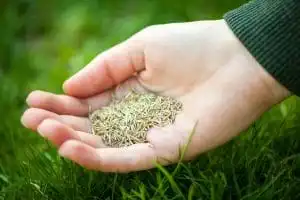The dog days of summer are gone. That means so is the summer yard work. Or is it? If you are looking forward to a lush lawn next spring, there’s one last chore to do before winter arrives. Autumn is the best season to start building a better lawn. Read on for helpful information on how to seed a lawn in fall.
Building a Better Lawn
Your lawn experiences a great deal of wear and tear during the active summer months. Heavy foot traffic, excessive heat, lack of water, pests, and weeds all take a toll on your turf. Brown spots, bare spots, or thinning areas may seem unimportant now that backyard barbeques are a thing of the past. But building a better lawn starts after the kids are back at school and the bathing suits are packed away. Why seed a lawn in fall? The cooler weather won’t dry out the seeds, but the soil is still warm enough to give grass a good growing environment. And there’s just enough sunshine and rainfall.
Preparing to Seed
Seeding is a cinch, but prepping the soil first is a must. The soil’s condition has to be just right to encourage grass seeds to grow. Here are some ways to get your yard ready for the process.
- Test your soil. Grass grows best when the soil has the right pH balance. If your soil is too acidic (pH lower than 6) add lime to improve it. But if your soil has a pH above 7.5, it’s too alkaline. Add peat moss instead.
- Remove debris, sticks, and rocks, and break up larger clumps of soil.
- Mow existing grass shorter than its height in summer.
- Get rid of thatch or aerate the lawn.
- If you are establishing a new lawn, add a layer of topsoil.
- If you are reseeding bare or thinning areas, loosen existing topsoil.
- Feed the soil before seeding by adding a little fertilizer.
Seed a Lawn in Fall
Now it’s time to plant the seeds. First, choose the right seed mix. You get what you pay for, so spending a little more on grass seed is a good investment. When deciding on the type of grass seed to use, carefully consider whether you want a warm-season grass or cool-season grass. This depends on the region’s climate. A lawn-care professional can help you pick out the type of seed that’s best for your yard.
Spread seeds evenly over the soil. For smaller areas sprinkle by hand, but use a spreader for larger areas or entire lawns. Don’t use too many seeds in one area, because they will compete for nutrients and water.
After seeding
The seed is applied, but there’s still a little more to do. Give your lawn a good watering and keep the soil moist while the seeds are germinating. Once they have germinated you can water less frequently, but deeper to allow the root system to get established. After seeding, it’s a good idea to apply a slow-release fertilizer that works best for your grass type.
Want to get your grass ready for spring? Start now by calling Free Spray Lawn Care at 419-529-5296 for tips and helpful information on how to properly seed a lawn in fall.



Comments (0)
Thanks for your comment!
Thanks for your feedback! Your comments have been successfully submitted! Please note, all comments require admin approval prior to display.
Error submitting comment!
There is a problem with your comment, please see below and try again.